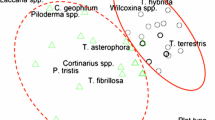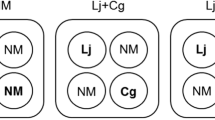Abstract
Ectomycorrhizal (EM) basidiomycete fungi are obligate mutualists of pines and hardwoods that receive fixed C from the host tree. Though they often share most recent common ancestors with wood-rotting fungi, it is unclear to what extent EM fungi retain the ability to express enzymes that break down woody substrates. In this study, we tested the hypothesis that the dominant EM fungus in a pure pine system retains the ability to produce enzymes that break down woody substrates in a natural setting, and that this ability is inducible by reduction of host photosynthetic potential via partial defoliation. To achieve this, pines in replicate blocks were defoliated 50% by needle removal, and enzyme activities were measured in individual EM root tips that had been treated with antibiotics to prevent possible bacterial activity. Results indicate that the dominant EM fungal species (Suillus granulatus) expressed all enzymes tested (endocellulase D-glucosidase, laccase, manganese peroxidase, lignin peroxidase, phosphatase and protease), and that activities of these enzymes increased significantly (P < 0.001) in response to defoliation. Thus, this EM fungus (one of the more specialized mutualists of pine) has the potential to play a significant role in C, N and P cycling in this forested ecosystem. Therefore, many above-ground factors that reduce photosynthetic potential or divert fixed C from roots may have wide-reaching ecosystem effects.
Similar content being viewed by others
References
Agerer R, Schloter M, Hahn C (2000) Fungal enzymatic activity in fruitbodies. Nova Hedwigia 71:315–336
Antibus RK, Sinsabaugh RL, Linkins AE (1992) Phosphatase activities and phosphorous uptake from inositol phosphate by ectomycorrhizal fungi. Can J Bot 70:794–801
Bendig GD, Read DJ (1995) The structure and function of the vegetative mycelium of ectomycorrhizal plants. V. Foraging behavior and translocation of nutrients from exploited litter. New Phytol 130:401–409
Bendig GD, Read DJ (1997) Lignin and soluble phenolic degredation by ectomycorrhizal and ericoid mycorrhizal fungi. Mycol Res 101:1348–1354
Berntson GM, Bazzaz FA (1997) Regenerating temperate forest mesocosms in elevated CO2: belowground growth and nitrogen cycling. Oecologia 113:115–125
Bonello P, Pearce RB (1993) Biochemical defense responses in primary roots of Scots pine challenged in vitro with Cylindrocarpon destructans. Plant Pathol 42:203–211
Brandrud TE (1995) The effects of experimental nitrogen addition on the ectomycorrhizal fungus flora in an oligotrophic spruce forest at Gardsjon, Sweden. For Ecol Manage 71:111–122
Burke RM, Carney JWG (2002) Laccases and other polyphenol oxidases in ecto- and ericoid mycorrhizal fungi. Mycorrhiza 12:105–116
Chalot M, Brun A (1998) Physiology of organic nitrogen acquisitioin by ectomycorrhizal fungi and ectomycorrhizas. FEMS Microbiol Rev 22:21–44
Colpaert JV, Van Laere A (1996) A comparison of the extracellular enzyme activities of two ectomycorrhizal and a leaf-saprophytic basidiomycetes colonizing beech leaf litter. New Phytol 133:133–141
Colpaert JW, Van Tichelen KK (1996) Decomposition, nitrogen and phosphorous mineralization from beech leaf litter colonized by ectomycorrhizal or litter-decomposing basidiomycetes. New Phytol 134:123–132
Conn C, Dighton J (2000) Litter quality influences on decomposition, ectomycorrhizal community structure and mycorrhizal root surface acid phosphatase activity. Soil Biol Biochem 32:489–496
Courty P-E, Breda N, Garbaye J (2007) Relation between oak tree phenology and the secretion of organic matter degrading enzymes by Lactarius quietus ectomycorrhzas before and during bud break. Soil Biol Biochem 39:1655–1663
Cullings KW, Szaro TM, Bruns TD (1996) Evolution of extreme specialization within a lineage of ectomycorrhizal epiparasites. Nature 379:63–66
Cullings KW, Vogler DR, Parker VT, Makhija S (2001) Defoliation effects on the ectomycorrhizal community of a mixed Pinus contorta/Picea engelmannii stand in Yellowstone Park. Oecologia 127:533–539
Cullings KW, New MH, Makhija S, Parker VT (2003) Effects of litter addition on the ectomycorrhizal associates of a lodgepole pine (Pinus contorta) stand in Yellowstone National Park. Appl Environ Microbiol 69:3772–3776
Cullings KW, Raleigh C, Vogler DR (2005) Effects of severe dwarf mistletoe infection on the ectomycorrhizal community of lodgepole pine in Yellowstone Park. Can J Bot 83:1174–1180
Cumming JR (1996) Phosphate-limitation physiology in ectomycorrhizal pitch pine (Pinus rigida) seedlings. Tree Physiol 16:977–983
Dass SB, Dosoretz CG, Reddy CA, Grethlein HE (1995) Extracellular proteases produced by the wood-degrading fungus Phanerochaete chrysosporium under ligninolytic and non-ligninolytic conditions. Arch Microbiol 163:254–258
De Souza CGM, Tychanowicz GV, De Souza F, Peralta RM (2004) Production of laccase isoforms by Pleurotus pulmonarius in response to presence of phenolic and aromatic compounds. J Basic Microbiol 44:129–136
Del Vecchio TA, Gehring CA, Cobb NS, Whitham TG (1993) Negative effects of scale insect herbivory on the ectomycorrhizae of juvenile Pinyon pine. Ecology 74:2297–2302
Durrall DM, Todd AW, Trappe JM (1994) Decomposition of 14C-labeled substrates by ectomycorrhizal fungi in association with Douglas-fir. New Phytol 127:725–729
Entry JA, Donnelley PK, Cromack K (1991) Influence of ectomycorrhizal mat soils on lignin and cellulose degradation. Biol Fertil Soils 11:75–78
Fields R (1972) The rapid determination of amino groups with TNBS. Methods Enzymol 25:464–468
Gehring CA, Whitham TG (1994) Comparisons of ectomycorrhizae on pinyon pines (Pinus edulis; Pinaceae) across extremes of soil type and herbivory. Am J Bot 81:1509–1516
Gehring CA, Whitham TG (1995) Duration of herbivore removal and environmental stress affect the ectomycorrhizae of Pinyon pines. Ecology 76(7):2118–2123
Godbold D, Berntson GM, Bazzaz FA (1997) Growth and mycorrhizal colonization of three North American tree species under elevated atmospheric CO2. New Phytol 137:433–440
Gold MH, Alic M (1993) Molecular biology of the lignin-degrading basidiomycetes Phanerochaete chrysosporium. Microbiol Rev 57:605–622
Gramss G, Günther TH, Fritsche W (1998) Spot tests for oxidative enzymes in ectomycorrhizal, wood and litter decaying fungi. Mycol Res 102:67–72
Günther TH, Perner B, Gramss G (1998) Activities of phenol oxidizing enzymes of ectomycorrhizal fungi in axenic culture and in symbiosis with Scots pine (Pinus sylvestris L.). J Basic Microbiol 38:197–206
Haselwandter K, Bobleter O, Read DJ (1990) Degredation of 14C-labeled lignin and dehydropolymer of coniferyl alcohol by ericoid and ectomycorrhizal fungi. Arch Microbiol 153:352–354
Hering TF (1982) Decomposing activity of basidiomycetes in forest litter. In: Frankland JC, Hedger JN, Swift MJ (eds) Decomposer basidiomycetes: their biology and ecology. Cambridge University Press, Cambridge, pp 213–225
Hibbett DS, Gilbert L-B, Donoghue MJ (2000) Evolutionary instability of ectomycorrhizal symbioses in basidiomycetes. Nature 407:506–508
Hummell KM, Inselman A, Ramos ER, Gathman AC, Lilly WW (1998) Extracellular protease production by submerged cultures of Schizophyllmu commune. Mycologia 90:883–889
Kjöller A (2006) Disproportionate abundance between ectomycorrhizal root tips and their associated mycelia. FEMS Microbiol Ecol 58:214–224
Kjöller A, Struwe S (2002) Enzymes in the environment. Activity, ecology and applications. Dekker, New York
Luis P, Walther G, Kellner H, Martin F, Buscot F (2004) Diversity of laccase genes from basidiomycetes in a forest soil. Soil Biol Biochem 36:1025–1036
Markkola AM (1996) Effect of artificial defoliation on biomass allocation ectomycorrhizal Pinus sylvestris seedlings. Can J For 26:899–904
Martin F, Delaruelle C, Hilbert JL (1990) An improved ergosterol assay to estimate fungal biomass in ectomycorrhizas. Mycol Res 94:1059–1064
Molina R, Massicotte J, Trappe JM (1992) Specificity phenomena in mycorrhizal symbioses: Community ecological consequences and practical applications. In: Allen A (ed) Mycorrhizal functioning. Chapman and Hall, New York, pp 357–420
Moorhead DL, Linkins AE (1997) Elevated CO2 alters belowground exoenzyme activities in tussock tundra. Plant Soil 189:321–329
Pritsch KS, Raidl E, Markensteiner H, Blashcke Agerer R, Schloter M, Hartmann A (2004) A rapid and highly sensitive method for measuring enzyme activities in single mycorrhizal tips using 4-methylumbelliferone-labeled fluorogenic substrates in a mciroplate system. J Microbiol Methods 58:233–241
Read DJ (1991) Mycorrhizas in ecosystems. Experientia 47:376–391
Redlak KH, Dahm H, Ciesielska A, Strezelczyk E (2001) Enzymatic activity of ectendomycorrhizal fungi. Biol Fertil Soils 33:83–90
Rossow LJ, Bryant JP, Kielland K (1997) Effects of above-ground browsing by mammals on mycorrhizal infection in an early sucessional taiga ecosystem. Oecologia 110:94–98
Simard SW, Perry DA, Jones MD, Myrold DD, Durall DM, Molina R (1998) Net transfer of carbon between ectomycorrhizal tree species in the field. Nature 388:579–582
Sinsabaugh R, Antibus R, Linkins A, McClaugherty AC, Rayburn L, Repert D, Weiland T (1993) Wood decomposition: nitrogen and phosphorus dynamics in relation to extracellular enzyme activity. Ecology 74:1586–1593
Sundari SK, Adholeya A (2000) Retention of enzyme activity following freeze-drying the mycelium of ectomycorrhizal isolates. Part II. Enzymes acting upon carbon compounds. World J Microbiol 16:865–868
Tabatabai MA, Bremner JM (1969) Use of p-nitrophenol phosphate for assay of soil phosphatase activity. Soil Biol Biochem 1:301–307
Taylor TN, Taylor EL (1997) The distribution and interactions of some Paleozoic fungi. Rev Paleobot Palynol 95:83–94
Tibbett M, Sanders FE, Cairney JWG, Leake JR (1999) Temperature regulation of extracellular proteases in ectomycorrhizal fungi (Hebeloma spp.) grown in axenic culture. Mycol Res 103:707–714
Timonen S, Sen R (1998) Heterogeneity of fungal and plant enzyme expression in intact Scots pine-Suillus bovines and–Paxillus involutus mycorrhizaospheres developed in natural forest humus. New Phytol 138:355–366
Walker RF, Geisinger DR, Johnson DW, Ball JT (1997) Elevated atmospheric CO2 and soil N fertility effects on growth, mycorrhizal colonization, and xylem water potential of juvenile ponderosa pine in a field soil. Plant Soil 195:25–36
Acknowledgements
This work was supported by an NSF grant to Henson and Cullings (NSF Ecology 0211848). We thank the Yellowstone Center for Resources for logistical support.
Author information
Authors and Affiliations
Corresponding author
Additional information
Communicated by Zoe Cardon.
Rights and permissions
About this article
Cite this article
Cullings, K., Ishkhanova, G. & Henson, J. Defoliation effects on enzyme activities of the ectomycorrhizal fungus Suillus granulatus in a Pinus contorta (lodgepole pine) stand in Yellowstone National Park. Oecologia 158, 77–83 (2008). https://doi.org/10.1007/s00442-008-1119-6
Received:
Accepted:
Published:
Issue Date:
DOI: https://doi.org/10.1007/s00442-008-1119-6




